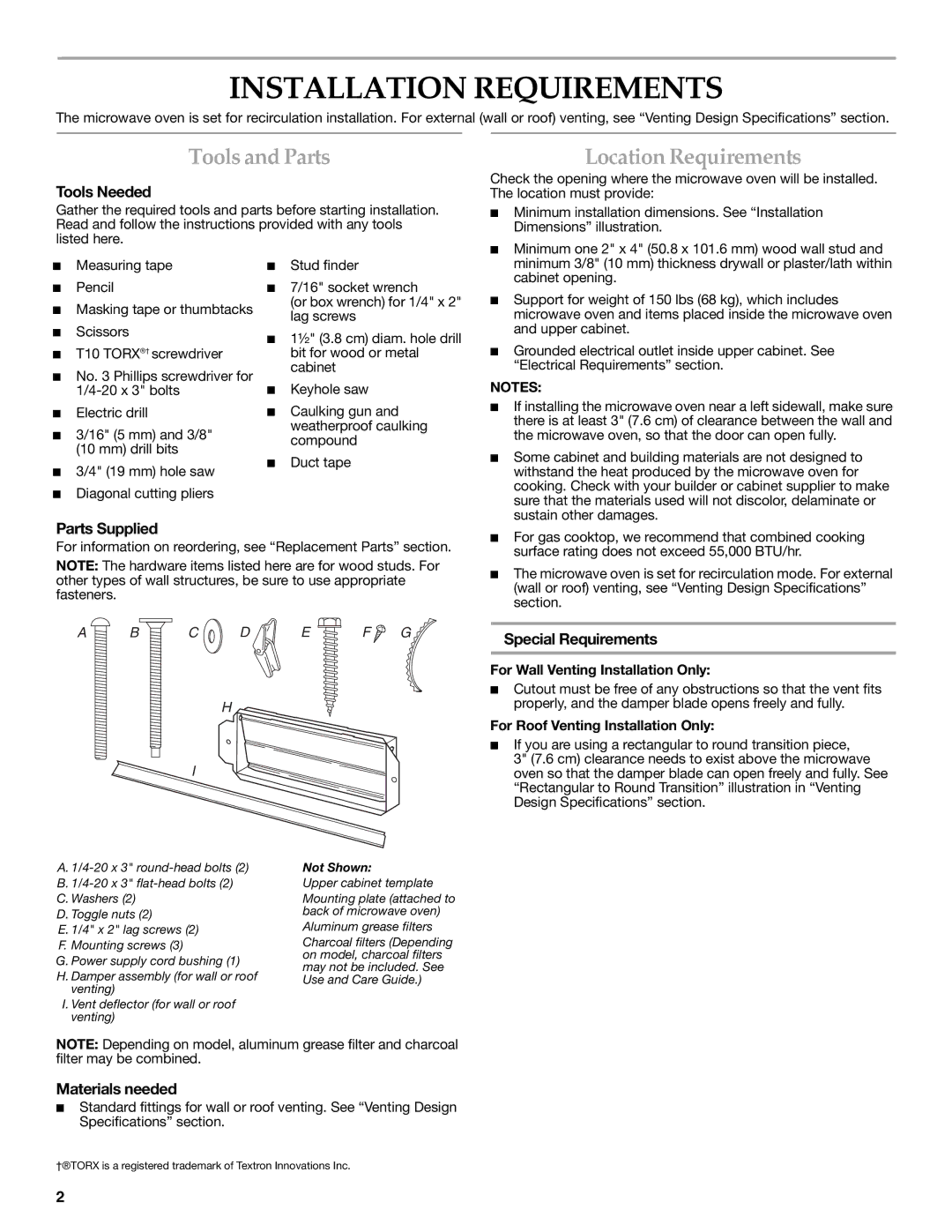
INSTALLATION REQUIREMENTS
The microwave oven is set for recirculation installation. For external (wall or roof) venting, see “Venting Design Specifications” section.
Tools and Parts
Tools Needed
Gather the required tools and parts before starting installation. Read and follow the instructions provided with any tools listed here.
Location Requirements
Check the opening where the microwave oven will be installed. The location must provide:
■ | Minimum installation dimensions. See “Installation |
| Dimensions” illustration. |
■ | Minimum one 2" x 4" (50.8 x 101.6 mm) wood wall stud and |
■Measuring tape
■Pencil
■Masking tape or thumbtacks
■Scissors
■T10 TORX®† screwdriver
■No. 3 Phillips screwdriver for
■Electric drill
■3/16" (5 mm) and 3/8" (10 mm) drill bits
■3/4" (19 mm) hole saw
■Diagonal cutting pliers
■Stud finder
■7/16" socket wrench
(or box wrench) for 1/4" x 2" lag screws
■1½" (3.8 cm) diam. hole drill bit for wood or metal cabinet
■Keyhole saw
■Caulking gun and weatherproof caulking compound
■Duct tape
minimum 3/8" (10 mm) thickness drywall or plaster/lath within |
cabinet opening. |
■ Support for weight of 150 lbs (68 kg), which includes |
microwave oven and items placed inside the microwave oven |
and upper cabinet. |
■ Grounded electrical outlet inside upper cabinet. See |
“Electrical Requirements” section. |
NOTES:
■ If installing the microwave oven near a left sidewall, make sure |
there is at least 3" (7.6 cm) of clearance between the wall and |
the microwave oven, so that the door can open fully. |
■ Some cabinet and building materials are not designed to |
withstand the heat produced by the microwave oven for |
cooking. Check with your builder or cabinet supplier to make |
sure that the materials used will not discolor, delaminate or |
sustain other damages. |
Parts Supplied
For information on reordering, see “Replacement Parts” section.
NOTE: The hardware items listed here are for wood studs. For other types of wall structures, be sure to use appropriate fasteners.
A  B
B  C
C  D E
D E  F
F  G
G
H
I
■ | For gas cooktop, we recommend that combined cooking |
| surface rating does not exceed 55,000 BTU/hr. |
■ | The microwave oven is set for recirculation mode. For external |
| (wall or roof) venting, see “Venting Design Specifications” |
| section. |
Special Requirements
For Wall Venting Installation Only:
■Cutout must be free of any obstructions so that the vent fits properly, and the damper blade opens freely and fully.
For Roof Venting Installation Only:
■If you are using a rectangular to round transition piece, 3" (7.6 cm) clearance needs to exist above the microwave oven so that the damper blade can open freely and fully. See “Rectangular to Round Transition” illustration in “Venting Design Specifications” section.
A.
D. Toggle nuts (2)
E. 1/4" x 2" lag screws (2) F. Mounting screws (3)
G. Power supply cord bushing (1)
H. Damper assembly (for wall or roof venting)
I. Vent deflector (for wall or roof venting)
Not Shown:
Upper cabinet template
Mounting plate (attached to back of microwave oven)
Aluminum grease filters
Charcoal filters (Depending on model, charcoal filters may not be included. See Use and Care Guide.)
NOTE: Depending on model, aluminum grease filter and charcoal filter may be combined.
Materials needed
■Standard fittings for wall or roof venting. See “Venting Design Specifications” section.
†®TORX is a registered trademark of Textron Innovations Inc.
2
